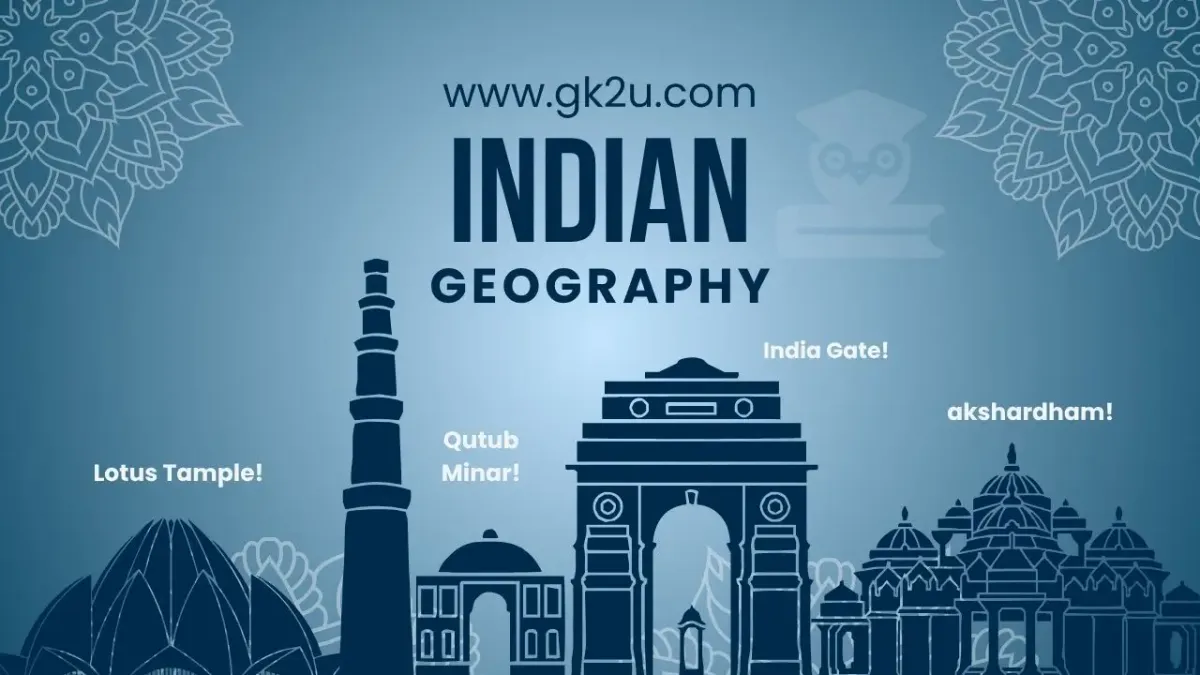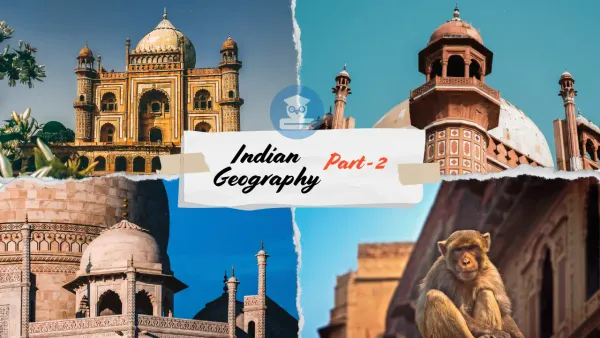Indian Geography – General Knowledge 2025 | Most Important GK for UPSC, APSC & SSC

Indian Geography – General Knowledge is an essential subject for aspirants preparing for various competitive examinations such as UPSC, APSC, SSC, RRB, Banking, and State-level recruitment exams. This section provides a comprehensive understanding of India’s physical, political, and economic geography in a simplified and exam-oriented manner.
India is a land of immense geographical diversity — from the towering Himalayas in the north to the Indian Ocean in the south, and from the Thar Desert in the west to the lush hills of the northeast. The study of Indian geography covers a wide range of topics including mountains, rivers, plateaus, plains, climate, soils, vegetation, and natural resources. It also includes detailed insights into agriculture, industries, transport networks, population distribution, and environmental issues.
A solid understanding of Indian geography not only helps in scoring better marks in competitive exams but also enhances one’s knowledge of the country’s natural and economic systems. It enables learners to understand how geography influences India’s culture, lifestyle, economy, and politics.
This “Indian Geography – General Knowledge” guide is designed with updated facts, maps, and key points to make learning easy and effective. Whether you are a student, a teacher, or an enthusiast who loves exploring India’s landscape, this resource serves as a complete and reliable study companion.
Get ready to explore India’s geographical wonders — from the mighty Ganges to the vast Deccan Plateau, and from the coastal plains to the high-altitude passes of Ladakh. Strengthen your knowledge and stay one step ahead in your exam preparation with our well-structured Indian Geography notes and quizzes.
1. The Paithan (Jayakwadi) Hydro-electric project, completed with the help of Japan, is on the river
A. Ganga
B. Cauvery
C. Narmada
D. Godavari
Correct Answer: D. Godavari
2. The percentage of irrigated land in India is about
A. 45
B. 65
C. 35
D. 25
Correct Answer: C. 35
3. The southernmost point of peninsular India, that is, Kanyakumari, is
A. north of Tropic of Cancer
B. south of the Equator
C. south of the Capricorn
D. north of the Equator
Correct Answer: D. north of the Equator
4. The pass located at the southern end of the Nilgiri Hills in south India is called
A. the Palghat gap
B. the Bhorghat pass
C. the Thalgat pass
D. the Bolan pass
Correct Answer: A. the Palghat gap
5. Which of the following factors are responsible for the rapid growth of sugar production in south India as compared to north India?
I. Higher per acre field of sugarcane
II. Higher sucrose content of sugarcane
III. Lower labor cost
IV. Longer crushing period
A. I and II
B. I, II and III
C. I, III and IV
D. I, II and IV
Correct Answer: D. I, II and IV
6. The principal copper deposits of India lie in which of the following places?
A. Hazaribag and Singbhum of Bihar
B. Khetri and Daribo areas of Rajasthan
C. Anantapur in Andhra Pradesh
D. Siwaliks in Uttar Pradesh and in Karnataka
Correct Answer: A. Hazaribag and Singbhum of Bihar
7. Which of the following are true regarding Jhum cultivation in India?
I. It is largely practiced in Assam
II. It is referred to as 'slash and burn' technique
III. In it, fertility is exhausted in a few years
A. I, II and III
B. II and III
C. I and II
D. I and III
Correct Answer: A. I, II and III
8. The Yarlung Zangbo River, in India, is known as
A. Ganga
B. Indus
C. Brahmaputra
D. Mahanadi
Correct Answer: C. Brahmaputra
9. The Salal Project is on the river
A. Chenab
B. Jhelum
C. Ravi
D. Sutlej
Correct Answer: A. Chenab
10. The only zone in the country that produces gold is also rich in iron is
A. North-eastern zone
B. North-western zone
C. Southern zone
D. None of the above
Correct Answer: C. Southern zone
11. The percentage of earth surface covered by India is
A. 2.4
B. 3.4
C. 4.4
D. 5.4
Correct Answer: A. 2.4
12. Which among the following is/are the major factor/factors responsible for the monsoon type of climate in India?
I. Location
II. Thermal contrast
III. Upper air circulation
IV. Inter-tropical convergence zone
A. I
B. II, III
C. II, III and IV
D. I, II, III and IV
Correct Answer: D. I, II, III and IV
13. The present forest area of India, according to satellite data, is
A. increasing
B. decreasing
C. static
D. decreasing in open forest area but increasing in closed forest area
Correct Answer: B. decreasing
14. The India's highest annual rainfall is reported at
A. Namchi, Sikkim
B. Churu, Rajasthan
C. Mawsynram, Meghalaya
D. Chamba, Himachal Pradesh
Correct Answer: C. Mawsynram, Meghalaya
15. The refineries are Mathura, Digboi and Panipat are set up by
A. Indian Oil Corporation Ltd.
B. Hindustan Petroleum Corporation Ltd.
C. Bharat Petroleum Corporation Ltd.
D. Crude Distillation unit of Madras Refineries Ltd
Correct Answer: A. Indian Oil Corporation Ltd.
16. What is the predominant type of Indian agriculture?
A. Commercial agriculture
B. Extensive agriculture
C. plantation agriculture
D. subsistence agriculture
Correct Answer: D. subsistence agriculture
17. The Radcliffe line is a boundary between
A. India and Pakistan
B. India and China
C. India and Myanmar
D. India and Afghanistan
Correct Answer: A. India and Pakistan
18. Which of the following has a potential for the harnessing of tidal energy in India?
A. Gulf of Cambay
B. Gulf of Mannar
C. Backwaters of Kerala
D. Chilka lake
Correct Answer: A. Gulf of Cambay
19. The typical area of sal forest in the Indian peninsular upland occurs
A. on the western ghats
B. between the Tapti and the Narmada
C. to the north-east of the Godavari
D. on the Malwa plateau
Correct Answer: D. on the Malwa plateau
20. The state having a largest area of forest cover in India is
A. Arunachal Pradesh
B. Haryana
C. Madhya Pradesh
D. Assam
Correct Answer: C. Madhya Pradesh
21. The year ____ is called a Great Divide in the demographic history of India.
A. 1901
B. 1921
C. 1941
D. 1951
Correct Answer: B. 1921
22. The only private sector refinery set up by Reliance Petroleum Ltd. is located at
A. Guwahati
B. Jamnagar
C. Mumbai
D. Chennai
Correct Answer: B. Jamnagar
23. The only state in India that produces saffron is
A. Assam
B. Himachal Pradesh
C. Jammu and Kashmir
D. Meghalaya
Correct Answer: C. Jammu and Kashmir
24. Three important rivers of the Indian subcontinent have their sources near the Mansarovar Lake in the Great Himalayas. These rivers are
A. Indus, Jhelum and Sutlej
B. Brahmaputra, Sutlej and Yamuna
C. Brahmaputra, Indus and Sutlej
D. Jhelum, Sutlej and Yamuna
Correct Answer: C. Brahmaputra, Indus and Sutlej
25. The zonal soil type of peninsular India belongs to
A. red soils
B. yellow soils
C. black soils
D. older alluvium
Correct Answer: A. red soils
26. The most plausible explanation for the location of the Thar desert in western India is
A. the obstruction caused by the Aravalis to the rain-bearing wind that proceeds to the Ganga Valley
B. the evaporation of moisture by heat
C. the absence of mountains to the north of Rajasthan to cause orographic rainfall in it
D. that the moisture carried by the South-west monsoon is driven away by the dry upper air current
Correct Answer: C. the absence of mountains to the north of Rajasthan to cause orographic rainfall in it
27. The northern boundary of the peninsular plateau of Indian runs parallel to the Ganga and the Yamuna from Rajmahal hills to a point near
A. Allahabad
B. Delhi
C. Gwalior
D. Jaipur
Correct Answer: B. Delhi
28. Which of the following food grain crops occupies the largest part of the cropped area in India?
A. Barley and maize
B. Jowar and bajra
C. Rice
D. Wheat
Correct Answer: C. Rice
29. The number of major languages, recognized in the Indian Union as official language, are
A. 15
B. 22
C. 12
D. 9
Correct Answer: B. 22
30. The oldest rocks in India are reported from
A. Dharwar region, Karnataka
B. Aravalli range, Rajasthan
C. Vindhyan range, Madhya Pradesh
D. Siwalik range, Punjab
Correct Answer: A. Dharwar region, Karnataka
31. Which of the following groups of rivers originate from the Himachal mountains?
A. Beas, Ravi and Chenab
B. Ravi, Chenab and Jhelum
C. Sutlej, Beas and Ravi
D. Sutlej, Ravi and Jhelum
Correct Answer: A. Beas, Ravi and Chenab
32. Which of the following groups of states has the largest deposits of iron ore?
A. Andhra Pradesh and Karnataka
B. Bihar and Orissa
C. Madhya Pradesh and Maharashtra
D. West Bengal and Assam
Correct Answer: B. Bihar and Orissa
33. Which of the following union territories of India has the highest density of population per sq km?
A. Pondicherry
B. Lakshadweep
C. Delhi
D. Chandigarh
Correct Answer: C. Delhi
34. which atomic power station in India is built completely indigenously?
A. Kalpakkam
B. Narora
C. Rawat Bhata
D. Tarapore
Correct Answer: A. Kalpakkam
35. The south-west monsoon contributes ____ of the total rain in India.
A. 86%
B. 50%
C. 22%
D. 100%
Correct Answer: A. 86%
36. The Shimla Convention is an agreement that sets
A. Shimla as a tourist spot
B. Shimla as the capital of Himachal Pradesh
C. boundary between India and Tibet
D. None of the above
Correct Answer: C. boundary between India and Tibet
37. Which of the following events took place in the Cenozoic era?
A. Formation of the rockies, India collides with Asia and the formation of the Himalayas and the Alps
B. Formation of the Appalachians and central European mountains
C. Splitting of India from Antarctic
D. Breaking up of Pangaea
Correct Answer: A. Formation of the rockies, India collides with Asia and the formation of the Himalayas and the Alps
38. The oldest oil field in India is the ____ field, in ____
A. Ankleshwar, Gujarat
B. Bombay High, Maharashtra
C. Nawagam, Gujarat
D. Digboi, Assam
Correct Answer: D. Digboi, Assam
39. Unlike other parts of the Indian Coast, fishing industry has not developed along the Saurashtra coast because
A. there are few indentions suitable for fishing
B. of overwhelming dependence on agriculture and animal husbandry
C. the sea water is relatively more saline
D. of industrial development leading to widespread pollution of coastal area
Correct Answer: B. of overwhelming dependence on agriculture and animal husbandry
40. The mountain building in Himalayas began
A. about 45 million years ago
B. when the continental plates of India and Eurasia converged on each other
C. both (a) and (b)
D. None of the above
Correct Answer: C. both (a) and (b)
41. The outer Himalayas lie between
A. the lease Himalayas and the Indo Gangetic plain
B. the foothills and the Indo Gangetic plain
C. the greater Himalayas and the Lesser Himalayas
D. Indo-Gangetic plains and the peninsula
Correct Answer: A. the lease Himalayas and the Indo Gangetic plain
42. Which of the following geographical features have played a great unifying role in strengthening the forces of homogeneity of the Indian people?
I. The expanses of water surrounding the peninsula
II. The Himalayan Mountains
III. The vastness of the country
IV. The presence of the Indian Ocean
A. I
B. II
C. I and II
D. I, II, III and IV
Correct Answer: D. I, II, III and IV
43. Which of the following drainage systems fall into Bay of Bengal?
A. Ganga, Brahmaputra and Godavari
B. Mahanadi, Krishna and Cauvery
C. Luni, Narmada and Tapti
D. Both (a) and (b)
Correct Answer: D. Both (a) and (b)
44. The oldest oil refinery in India is at
A. Digboi, Assam
B. Haldia, near Kolkata
C. Koyali, near Baroda
D. Noonmati, Assam
Correct Answer: A. Digboi, Assam
45. The oldest mountains in India are
A. Aravalis
B. Vindhyas
C. Satpura
D. Nilgiri hills
Correct Answer: A. Aravalis
46. Which of the following groups of rivers have their source of origin in Tibet?
A. Brahmaputra, Ganges and Sutlej
B. Ganges, Sutlej and Yamuna
C. Brahmaputra, Indus and Sutlej
D. Chenab, Ravi and Sutlej
Correct Answer: C. Brahmaputra, Indus and Sutlej
47. Which of the following measures are effective for soil conservation in India?
I. Avoiding crop rotation
II. Afforestation
III. Encouraging the use of chemical fertilizers
IV. Limiting shifting cultivation
A. I and II
B. II and IV
C. III and IV
D. I, II and III
Correct Answer: B. II and IV
48. Which of the following crops needs maximum water per hectare?
A. Barley
B. Maize
C. Sugarcane
D. Wheat
Correct Answer: C. Sugarcane
49. The watershed between India and Myanmar is formed by
A. the Naga Hills
B. the Garo Hills
C. Khasi Hills
D. the Jaintia Hills
Correct Answer: A. the Naga Hills
50. The originating in the Himalayan mountain complex consists of how many distinct drainage systems of the Indian Subcontinent?
A. Two
B. Three
C. Four
D. Five
Correct Answer: B. Three
51. The percentage of India's total population employed in agriculture is nearly
A. 40%
B. 50%
C. 60%
D. 70%
Correct Answer: D. 70%
52. Which of the following important rivers of India does not originate from the Western Ghats?
A. Cauvery
B. Godavari
C. Krishna
D. Mahanadi
Correct Answer: D. Mahanadi
53. Which of the following areas or regions is most prone to earthquakes?
A. Ganga-Brahmaputra valley
B. Deccan plateau
C. Plains of northern India
D. Western Ghats
Correct Answer: A. Ganga-Brahmaputra valley
54. The proportion of forest to the total national geographical area of India as envisaged by National Forest Policy is
A. 30.3%
B. 33.3%
C. 38.3%
D. 42.3%
Correct Answer: B. 33.3%
55. Which of the following dams has generations of power more than irrigation as its main purpose?
A. Gandhi Sagar
B. Hirakud
C. Periyar
D. Tungabhadra
Correct Answer: A. Gandhi Sagar
56. Which of the following crops is regarded as a plantation crop?
A. Coconut
B. Cotton
C. Sugarcane
D. Rice
Correct Answer: A. Coconut
57. Which of the following countries leads in the production of aluminum and its products in the world?
A. Australia
B. France
C. India
D. USA
Correct Answer: D. USA
58. The natural region which holds the Indian subcontinent is
A. equatorial climate change region
B. hot desert
C. monsoon
D. Mediterranean
Correct Answer: C. monsoon
59. The most ideal region for the cultivation of cotton in India is
A. the Brahmaputra Valley
B. the Indo-Gangetic Valley
C. the Deccan Plateau
D. the Rann of Kutch
Correct Answer: C. the Deccan Plateau
60. Which of the following are true with respect to the Indian Peninsular Plateau?
I. The southern plateau block is formed mainly of granite and gneiss
II. The Deccan lava plateau is an elevated tableland consisting of horizontally arranged lava sheets
III. The Malwa plateau dominates the Vindhya scraps, forming the northern flank of the plateau
IV. The trough of the Narmada and Tapti are interposed between the Vindhya and the Satpura ranges
A. I, II and III
B. I and II
C. I, II, III and IV
D. I, III and IV
Correct Answer: C. I, II, III and IV
61. Which of the following types of soil are mostly confined to river basins and coastal plains of India?
A. Alluvial soils
B. Black soils
C. Laterite soils
D. Red soils
Correct Answer: A. Alluvial soils
62. The two states of India, most richly endowed with iron ore, are
A. Bihar and Orissa
B. Madhya Pradesh and Orissa
C. Bihar and West Bengal
D. Madhya Pradesh and West Bengal
Correct Answer: A. Bihar and Orissa
63. The most fertile region of India is
A. the Himalayas
B. the central Highlands
C. the Indo-Gangetic plain
D. peninsular plateau
Correct Answer: C. the Indo-Gangetic plain
64. Which of the following groups accounts for over 90 percent of India's annual coal production?
A. Bihar, Orissa and West Bengal
B. Bihar, Orissa and Madhya Pradesh
C. Orissa, Madhya Pradesh and Tamil Nadu
D. West Bengal, Madhya Pradesh and Tamil Nadu
Correct Answer: A. Bihar, Orissa and West Bengal
65. The significant shifts in Indian agriculture during green revolution include
A. non-food grains reported some spectacular progress and shift in the cropping pattern
B. major food grains, in the eastern regions productions decreased and in the northern states increased
C. both (a) and (b)
D. None of the above
Correct Answer: C. both (a) and (b)
66. The number of major ports in India is
A. 5
B. 8
C. 13
D. 15
Correct Answer: C. 13
67. Which of the following is a peninsular river of India?
A. Gandak
B. Kosi
C. Krishna
D. Sutlej
Correct Answer: C. Krishna
68. Which of the following is the most important raw material for the generation of power in India?
A. Coal
B. Mineral Oil
C. Natural Gas
D. Uranium
Correct Answer: A. Coal
69. When it is noon IST at Allahabad in India, the time at Greenwich, London, will be
A. midnight, GMT
B. 1730 hours
C. 0630 hours
D. None of the above
Correct Answer: C. 0630 hours
70. Which country has the largest coastline?
A. USA
B. Australia
C. Canada
D. India
Correct Answer: C. Canada
71. The river Godavari is often referred to as Vridha Ganga because
A. it is the older river of India
B. of its large size and extent among the peninsular rivers
C. there are a fairly large number of pilgrimage centers situated on its banks
D. its length is nearly the same as that of the river Ganges
Correct Answer: B. of its large size and extent among the peninsular rivers
72. The scarcity or crop failure of which of the following can cause a serious edible oil crisis in India?
A. coconut
B. Groundnut
C. Linseed
D. Mustard
Correct Answer: B. Groundnut
73. The pennines (Europe), Appalachians (America) and the Aravallis (India) are examples of
A. old mountains
B. young mountains
C. fold mountains
D. block mountains
Correct Answer: A. old mountains
74. Which of the following factors are responsible for the present crisis in the jute industry in India?
I. The decline in the overseas market
II. Inadequately supply of raw jute
III. Stiff competition from synthetic packing materials
Select the correct answer from the codes given below
A. I and II
B. I, II and III
C. I and III
D. II and III
Correct Answer: A. I and II
75. Which of the following factors are responsible for India's failure to fully exploit the inland fisheries during the last five decades?
I. Silting and pollution of the inland water bodies
II. Deforestation in the catchment areas of the rivers
III. Lack of marketing facilities
Select the correct answer from the codes given below
A. I, II and III
B. I and II
C. I and III
D. II and III
Correct Answer: C. I and III





